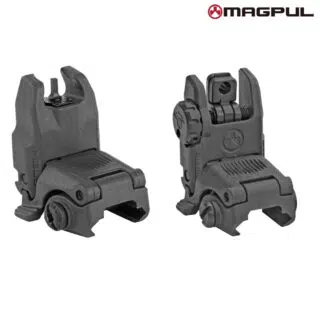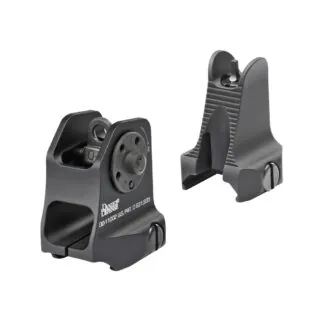AR-15 Backup Sights: Why You Need Them & Which to Consider
These days, it seems like everyone knows the exact optic they are going to mount on their AR-15 before they even order the rifle! Whether it be a red dot, LPVO, holographic sight, or prism scope, the optic can often be the star of the show.
However, what happens if that optic fails? They can run out of batteries, their glass can shatter, or they can completely fall off and become lost. While all of that is unlikely to happen aside from the batteries running out, you should always be prepared for them to. That is where backup sights come into play.
There are many different forms of backup sights, from flip-up to fixed and offset to top-mounted. Regardless of which style makes the most sense for your rifle’s configuration, I’m here to tell you that having some sort of backup sights is a must!
Types of Backup Sights
Before you can go down the path of purchasing a set of backup sights, you’ll quickly have to understand what each type of sight brings to the table.
Flip-up
Arguably the most popular, flip-up backup sights are exactly what they sound like! These sights can be deployed, a.k.a. ” flipped up” when you need to use them and then appropriately tucked away when you don’t.
These are often spring-loaded and constructed from polymer or steel. Of course, there are manual options, but it will just come down to personal preference.
If the sights are low-profile enough, you can even have your LPVO or scope go directly over the rear sight, so you don’t have to be limited in your optic choices.
There are many sets of flip-up sights that I would recommend, but the ones I use most often on my own rifles are from the Magpul MBUS (Magpul Back-up Sight) line. The MBUS line offers polymer and steel options, both of which are low-profile and easy to adjust.
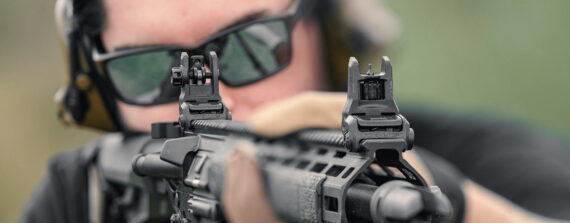
Flip-up sights take up very little rail space. Source: magpul
Fixed
Typically more durable than flip-up sights, fixed sights can not be tucked away when not in use. If you have no plan to run an LPVO or scope, this type of sight can be an excellent option to ensure you are always ready to go.
These are usually made of steel and are a tad bulkier, meaning they will be heavier. Since, more often than not, they won’t be run with the larger optics, the weight tradeoff can actually balance itself out.
A popular and proven set of fixed sights to consider if this is the route you decide to take is the Daniel Defense Rail Mounted Fixed Sights.
They are machined from 6061-T6 aluminum with a MIL-SPEC hard-coat anodized finish and have a patented “Rock and Lock” mounting system, which makes them quick and easy to take on and off if you need to.
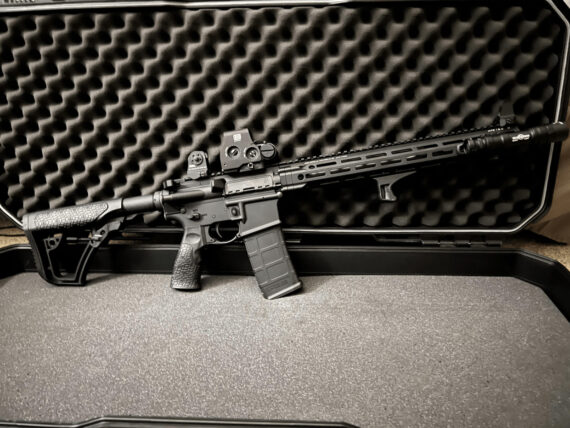
Fixed sights still allow the use of many different optics. Source: reddit
Offset
Have you ever noticed someone tilting their rifle while transitioning between targets? Chances are high that they are switching to offset iron sights from their scope. You don’t see offset sights too often, but once you do, you can see why they make so much sense.
These sights mount at roughly 45 degrees and stay completely out of the way of your chosen optic. If you’re running a long-range scope and need to acquire a target up close quickly, you can simply rotate your rifle and lock on quickly thanks to the offset sights.
I don’t typically run offset sights, but if I did, I would likely default to the Magpul MBUS line again, as it offers a lightweight and tool-less offering in this arena, too.
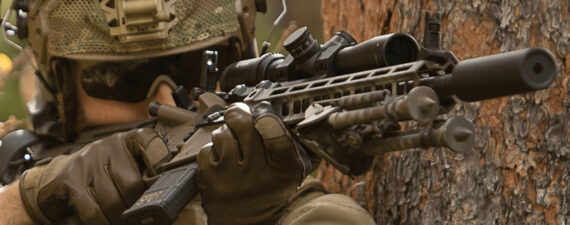
You’d be surprised how quickly you adapt to a 45-degree offset. Source: magpul
Pros & Cons
If you’ve made it this far, you can likely guess the pros and cons, but let’s sum them up quickly.
Backup Sight Pros:
- No batteries needed
- Lightweight
- Affordable
- Durable
Backup Sight Cons:
- Adds cost to your build
- Takes up space from other attachments
- Limited range
Some of these pros and cons go both ways. Yes, they add weight, but only a very small amount. They do take space from other attachments, but less than, say, a scope. You’ll always have a way to aim but will be limited to closer distances than you would with an optic.
However, backup sights are meant to supplement your optic, not replace it, so you wind up getting the best of both worlds in many scenarios.
Parting Thoughts
At the end of the day, having a set of backup sights on your rifle is all about being prepared. Being prepared for a scenario that may never happen is not a bad thing, and you’ll never regret having them and not needing them, but you sure as heck will if it’s the opposite.
Do yourself a favor and buy a set. You can always take them off and sell them if you don’t like them.
If I were to recommend one set of sights, it would easily be the Magpul MBUS. They are lightweight, durable, and don’t break the bank. That’s not to say there aren’t many other high-quality options out there, but you really can’t go wrong with those from Magpul.
As always, stay safe, train hard, and have fun.
